Yushun Tang
Domain-Conditioned Transformer for Fully Test-time Adaptation
Oct 14, 2024Abstract:Fully test-time adaptation aims to adapt a network model online based on sequential analysis of input samples during the inference stage. We observe that, when applying a transformer network model into a new domain, the self-attention profiles of image samples in the target domain deviate significantly from those in the source domain, which results in large performance degradation during domain changes. To address this important issue, we propose a new structure for the self-attention modules in the transformer. Specifically, we incorporate three domain-conditioning vectors, called domain conditioners, into the query, key, and value components of the self-attention module. We learn a network to generate these three domain conditioners from the class token at each transformer network layer. We find that, during fully online test-time adaptation, these domain conditioners at each transform network layer are able to gradually remove the impact of domain shift and largely recover the original self-attention profile. Our extensive experimental results demonstrate that the proposed domain-conditioned transformer significantly improves the online fully test-time domain adaptation performance and outperforms existing state-of-the-art methods by large margins.
Window-based Channel Attention for Wavelet-enhanced Learned Image Compression
Sep 21, 2024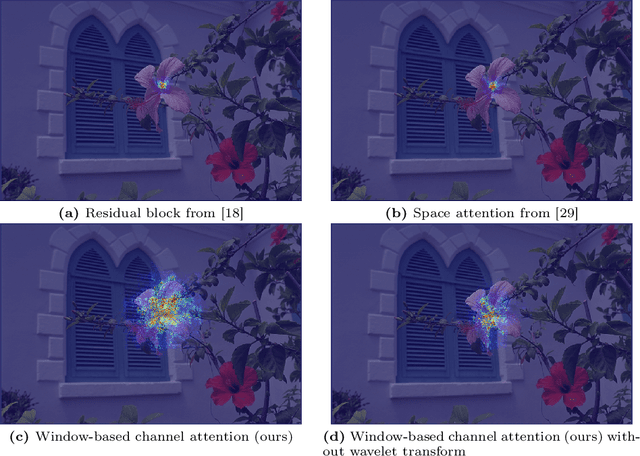
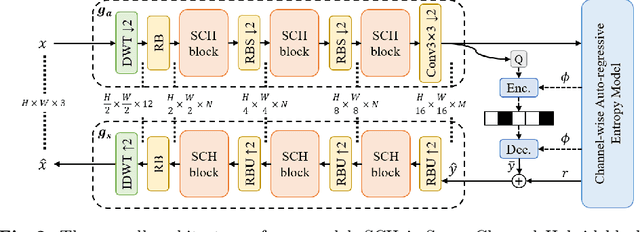
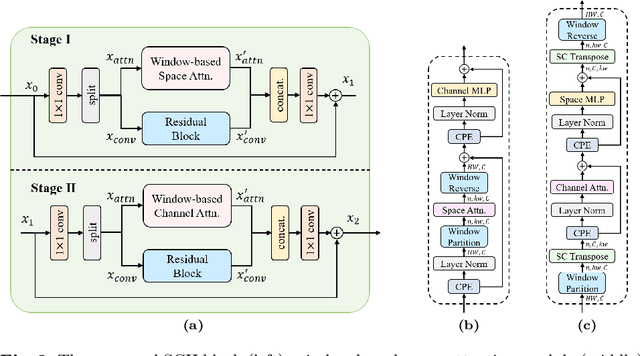

Abstract:Learned Image Compression (LIC) models have achieved superior rate-distortion performance than traditional codecs. Existing LIC models use CNN, Transformer, or Mixed CNN-Transformer as basic blocks. However, limited by the shifted window attention, Swin-Transformer-based LIC exhibits a restricted growth of receptive fields, affecting the ability to model large objects in the image. To address this issue, we incorporate window partition into channel attention for the first time to obtain large receptive fields and capture more global information. Since channel attention hinders local information learning, it is important to extend existing attention mechanisms in Transformer codecs to the space-channel attention to establish multiple receptive fields, being able to capture global correlations with large receptive fields while maintaining detailed characterization of local correlations with small receptive fields. We also incorporate the discrete wavelet transform into our Spatial-Channel Hybrid (SCH) framework for efficient frequency-dependent down-sampling and further enlarging receptive fields. Experiment results demonstrate that our method achieves state-of-the-art performances, reducing BD-rate by 18.54%, 23.98%, 22.33%, and 24.71% on four standard datasets compared to VTM-23.1.
Dual-Path Adversarial Lifting for Domain Shift Correction in Online Test-time Adaptation
Aug 26, 2024

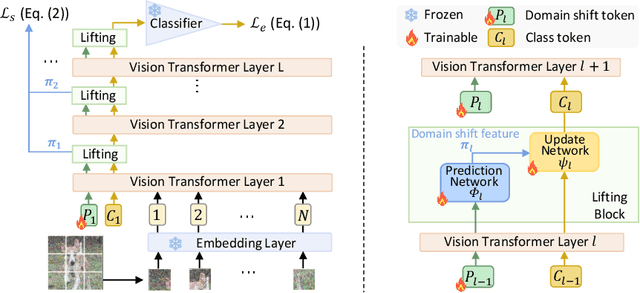
Abstract:Transformer-based methods have achieved remarkable success in various machine learning tasks. How to design efficient test-time adaptation methods for transformer models becomes an important research task. In this work, motivated by the dual-subband wavelet lifting scheme developed in multi-scale signal processing which is able to efficiently separate the input signals into principal components and noise components, we introduce a dual-path token lifting for domain shift correction in test time adaptation. Specifically, we introduce an extra token, referred to as \textit{domain shift token}, at each layer of the transformer network. We then perform dual-path lifting with interleaved token prediction and update between the path of domain shift tokens and the path of class tokens at all network layers. The prediction and update networks are learned in an adversarial manner. Specifically, the task of the prediction network is to learn the residual noise of domain shift which should be largely invariant across all classes and all samples in the target domain. In other words, the predicted domain shift noise should be indistinguishable between all sample classes. On the other hand, the task of the update network is to update the class tokens by removing the domain shift from the input image samples so that input samples become more discriminative between different classes in the feature space. To effectively learn the prediction and update networks with two adversarial tasks, both theoretically and practically, we demonstrate that it is necessary to use smooth optimization for the update network but non-smooth optimization for the prediction network. Experimental results on the benchmark datasets demonstrate that our proposed method significantly improves the online fully test-time domain adaptation performance. Code is available at \url{https://github.com/yushuntang/DPAL}.
Learning Visual Conditioning Tokens to Correct Domain Shift for Fully Test-time Adaptation
Jun 27, 2024Abstract:Fully test-time adaptation aims to adapt the network model based on sequential analysis of input samples during the inference stage to address the cross-domain performance degradation problem of deep neural networks. This work is based on the following interesting finding: in transformer-based image classification, the class token at the first transformer encoder layer can be learned to capture the domain-specific characteristics of target samples during test-time adaptation. This learned token, when combined with input image patch embeddings, is able to gradually remove the domain-specific information from the feature representations of input samples during the transformer encoding process, thereby significantly improving the test-time adaptation performance of the source model across different domains. We refer to this class token as visual conditioning token (VCT). To successfully learn the VCT, we propose a bi-level learning approach to capture the long-term variations of domain-specific characteristics while accommodating local variations of instance-specific characteristics. Experimental results on the benchmark datasets demonstrate that our proposed bi-level visual conditioning token learning method is able to achieve significantly improved test-time adaptation performance by up to 1.9%.
Concept-Guided Prompt Learning for Generalization in Vision-Language Models
Jan 15, 2024Abstract:Contrastive Language-Image Pretraining (CLIP) model has exhibited remarkable efficacy in establishing cross-modal connections between texts and images, yielding impressive performance across a broad spectrum of downstream applications through fine-tuning. However, for generalization tasks, the current fine-tuning methods for CLIP, such as CoOp and CoCoOp, demonstrate relatively low performance on some fine-grained datasets. We recognize the underlying reason is that these previous methods only projected global features into the prompt, neglecting the various visual concepts, such as colors, shapes, and sizes, which are naturally transferable across domains and play a crucial role in generalization tasks. To address this issue, in this work, we propose Concept-Guided Prompt Learning (CPL) for vision-language models. Specifically, we leverage the well-learned knowledge of CLIP to create a visual concept cache to enable concept-guided prompting. In order to refine the text features, we further develop a projector that transforms multi-level visual features into text features. We observe that this concept-guided prompt learning approach is able to achieve enhanced consistency between visual and linguistic modalities. Extensive experimental results demonstrate that our CPL method significantly improves generalization capabilities compared to the current state-of-the-art methods.
BDC-Adapter: Brownian Distance Covariance for Better Vision-Language Reasoning
Sep 03, 2023



Abstract:Large-scale pre-trained Vision-Language Models (VLMs), such as CLIP and ALIGN, have introduced a new paradigm for learning transferable visual representations. Recently, there has been a surge of interest among researchers in developing lightweight fine-tuning techniques to adapt these models to downstream visual tasks. We recognize that current state-of-the-art fine-tuning methods, such as Tip-Adapter, simply consider the covariance between the query image feature and features of support few-shot training samples, which only captures linear relations and potentially instigates a deceptive perception of independence. To address this issue, in this work, we innovatively introduce Brownian Distance Covariance (BDC) to the field of vision-language reasoning. The BDC metric can model all possible relations, providing a robust metric for measuring feature dependence. Based on this, we present a novel method called BDC-Adapter, which integrates BDC prototype similarity reasoning and multi-modal reasoning network prediction to perform classification tasks. Our extensive experimental results show that the proposed BDC-Adapter can freely handle non-linear relations and fully characterize independence, outperforming the current state-of-the-art methods by large margins.
Cross-Modal Concept Learning and Inference for Vision-Language Models
Jul 28, 2023



Abstract:Large-scale pre-trained Vision-Language Models (VLMs), such as CLIP, establish the correlation between texts and images, achieving remarkable success on various downstream tasks with fine-tuning. In existing fine-tuning methods, the class-specific text description is matched against the whole image. We recognize that this whole image matching is not effective since images from the same class often contain a set of different semantic objects, and an object further consists of a set of semantic parts or concepts. Individual semantic parts or concepts may appear in image samples from different classes. To address this issue, in this paper, we develop a new method called cross-model concept learning and inference (CCLI). Using the powerful text-image correlation capability of CLIP, our method automatically learns a large set of distinctive visual concepts from images using a set of semantic text concepts. Based on these visual concepts, we construct a discriminative representation of images and learn a concept inference network to perform downstream image classification tasks, such as few-shot learning and domain generalization. Extensive experimental results demonstrate that our CCLI method is able to improve the performance upon the current state-of-the-art methods by large margins, for example, by up to 8.0% improvement on few-shot learning and by up to 1.3% for domain generalization.
Cross-Inferential Networks for Source-free Unsupervised Domain Adaptation
Jun 29, 2023



Abstract:One central challenge in source-free unsupervised domain adaptation (UDA) is the lack of an effective approach to evaluate the prediction results of the adapted network model in the target domain. To address this challenge, we propose to explore a new method called cross-inferential networks (CIN). Our main idea is that, when we adapt the network model to predict the sample labels from encoded features, we use these prediction results to construct new training samples with derived labels to learn a new examiner network that performs a different but compatible task in the target domain. Specifically, in this work, the base network model is performing image classification while the examiner network is tasked to perform relative ordering of triplets of samples whose training labels are carefully constructed from the prediction results of the base network model. Two similarity measures, cross-network correlation matrix similarity and attention consistency, are then developed to provide important guidance for the UDA process. Our experimental results on benchmark datasets demonstrate that our proposed CIN approach can significantly improve the performance of source-free UDA.
Self-Correctable and Adaptable Inference for Generalizable Human Pose Estimation
Mar 25, 2023Abstract:A central challenge in human pose estimation, as well as in many other machine learning and prediction tasks, is the generalization problem. The learned network does not have the capability to characterize the prediction error, generate feedback information from the test sample, and correct the prediction error on the fly for each individual test sample, which results in degraded performance in generalization. In this work, we introduce a self-correctable and adaptable inference (SCAI) method to address the generalization challenge of network prediction and use human pose estimation as an example to demonstrate its effectiveness and performance. We learn a correction network to correct the prediction result conditioned by a fitness feedback error. This feedback error is generated by a learned fitness feedback network which maps the prediction result to the original input domain and compares it against the original input. Interestingly, we find that this self-referential feedback error is highly correlated with the actual prediction error. This strong correlation suggests that we can use this error as feedback to guide the correction process. It can be also used as a loss function to quickly adapt and optimize the correction network during the inference process. Our extensive experimental results on human pose estimation demonstrate that the proposed SCAI method is able to significantly improve the generalization capability and performance of human pose estimation.
Neuro-Modulated Hebbian Learning for Fully Test-Time Adaptation
Mar 10, 2023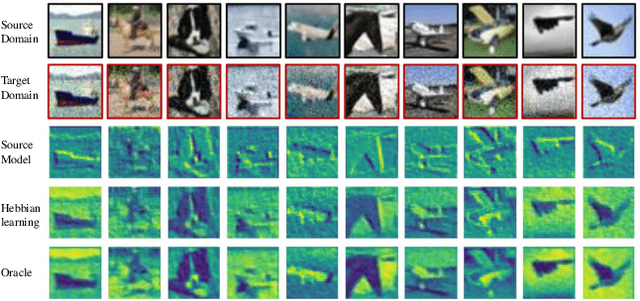
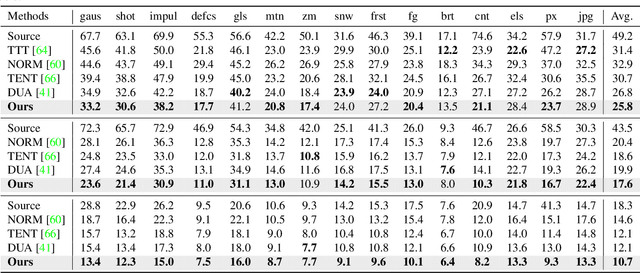
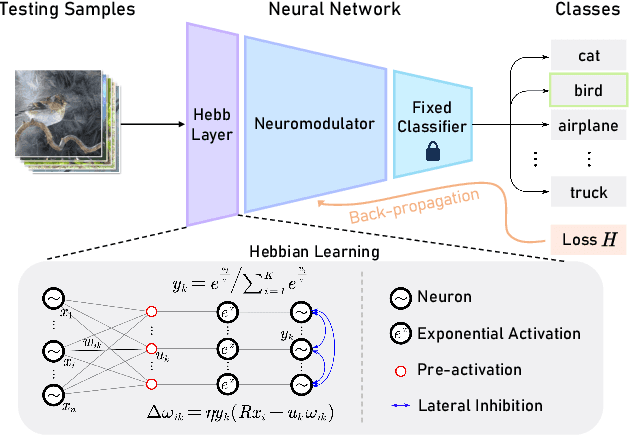

Abstract:Fully test-time adaptation aims to adapt the network model based on sequential analysis of input samples during the inference stage to address the cross-domain performance degradation problem of deep neural networks. We take inspiration from the biological plausibility learning where the neuron responses are tuned based on a local synapse-change procedure and activated by competitive lateral inhibition rules. Based on these feed-forward learning rules, we design a soft Hebbian learning process which provides an unsupervised and effective mechanism for online adaptation. We observe that the performance of this feed-forward Hebbian learning for fully test-time adaptation can be significantly improved by incorporating a feedback neuro-modulation layer. It is able to fine-tune the neuron responses based on the external feedback generated by the error back-propagation from the top inference layers. This leads to our proposed neuro-modulated Hebbian learning (NHL) method for fully test-time adaptation. With the unsupervised feed-forward soft Hebbian learning being combined with a learned neuro-modulator to capture feedback from external responses, the source model can be effectively adapted during the testing process. Experimental results on benchmark datasets demonstrate that our proposed method can significantly improve the adaptation performance of network models and outperforms existing state-of-the-art methods.
 Add to Chrome
Add to Chrome Add to Firefox
Add to Firefox Add to Edge
Add to Edge